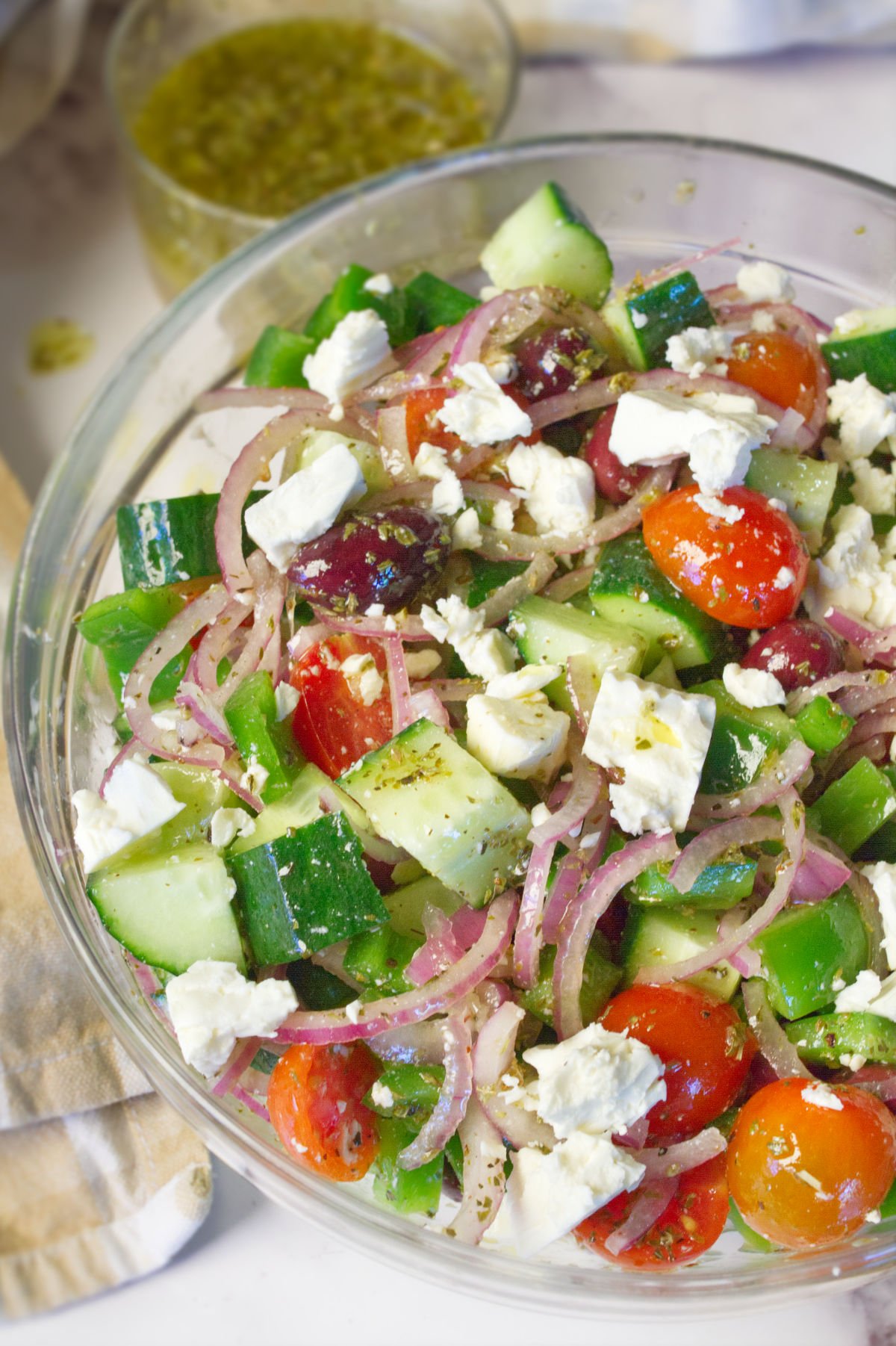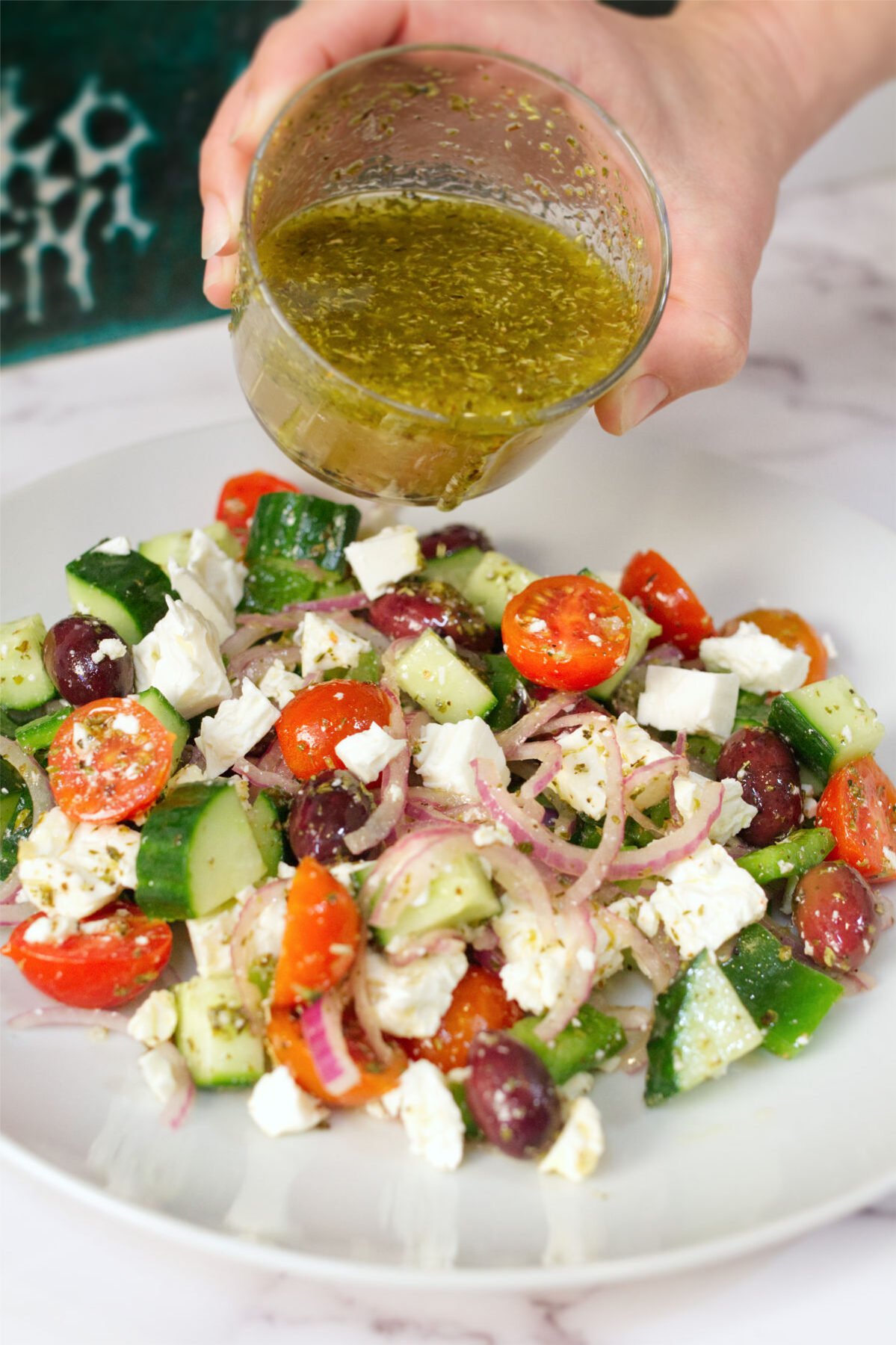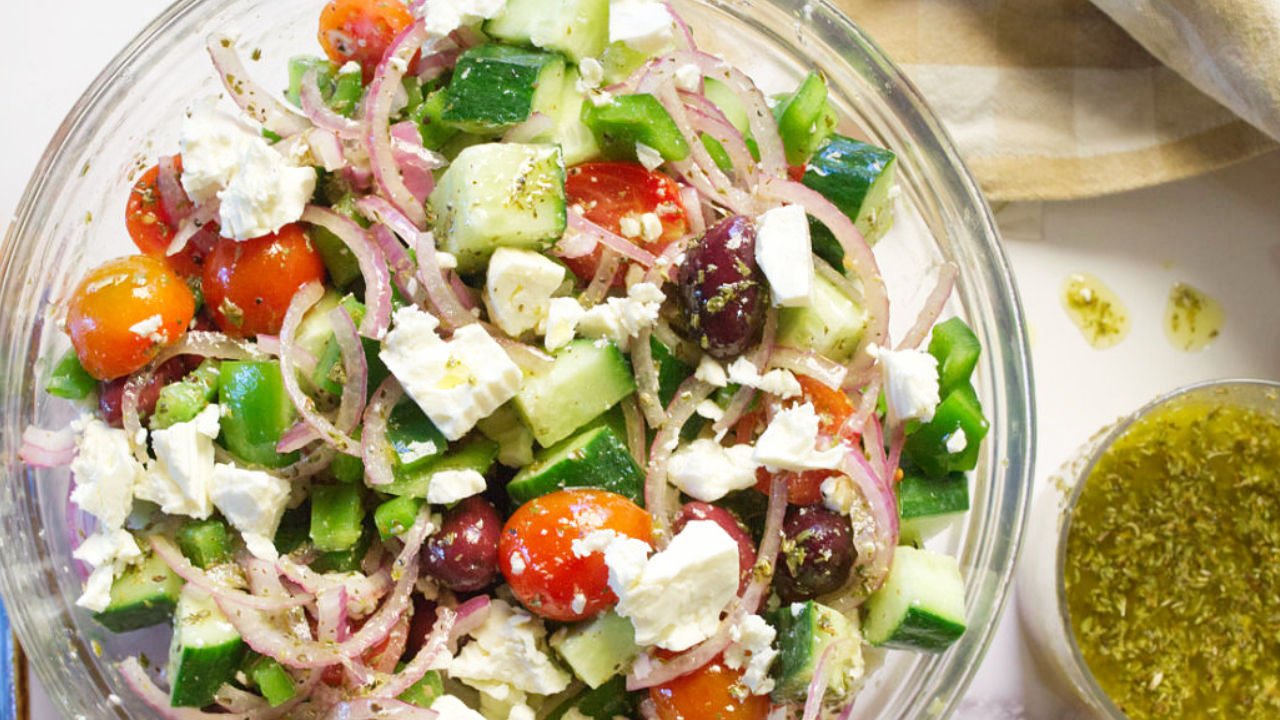Who doesn’t love a fresh and healthy Horiatiki Greek salad? Rooted in Mediterranean cuisine, Greek salad is a classic dish renowned for its simplicity and vibrant flavors. The salad features a refreshing combination of juicy tomatoes, crunchy cucumbers, tangy red onion, topped with Kalamata olives, and creamy feta cheese, all tossed in a light dressing of olive oil, lemon juice, and oregano.
What makes the classic Greek salad truly delightful is not just its delicious taste and numerous health benefits, but also its ease of preparation. With readily available ingredients and no cooking involved, crafting a Greek salad is as effortless as it is satisfying, making it a perfect choice for a quick and healthy meal any time of the year.
With around 10 minutes of prep and ZERO cooking, we show you how to make a healthy Horiatiki Greek salad plus an easy salad dressing.
Table of contents:
- Why Horiatiki Greek Salad is So Awesome!
- How to Make Horiatiki Greek Salad
- Origin of Horiatiki Greek Salad
- Ladolemono Salad Dressing
- Serving Suggestions:
- Horiatiki Greek Salad Cooking Tips
Why Horiatiki Greek Salad is So Awesome!
- Quick and easy to make- Ready in 10 minutes!
- Iconic Mediterranean flavors
- Healthy and Nutritious
- Part of the Mediterranean diet
- Versatile and adaptable- Add or omit ingredients as you choose!
- Simple yet flavorful salad dressing
- Fresh and vibrant ingredients
How to Make Horiatiki Greek Salad
Ingredients
For the salad
- 1 English cucumber, diced
- 1 cup cherry tomatoes, halved
- 1 green bell pepper, diced
- ½ red onion, thinly sliced
- ½ cup Kalamata olives
- 4 oz (110 g) feta cheese, crumbled
- salt and pepper to taste
For the easy dressing (Ladolemono)
- ½ cup extra virgin olive oil
- ¼ cup lemon juice (freshly squeezed is best)
- 1 teaspoon dried oregano
- ½ teaspoon salt (to taste)
- Cracked black pepper (to taste)
Equipment
- Large bowl
- Large kitchen knife and cutting board
- Medium-sized bowl (or glass jar)
- Whisk
Instructions
Step 1 – Prepare the Salad Dressing (Ladolemono)
- Whisk together the lemon juice and the extra virgin olive oil.
- Add the minced garlic, and herbs, and season with salt and pepper. Whisk again and check the flavor.
Step 2 – Prepare Veggies
- Chop cucumber into bite-sized pieces; quarter moons about 1/8th inch thick work well.
- Dice the green pepper into small pieces (a little smaller than the cucumber).
- Cut the cherry tomatoes in half, and finely slice the red onion into half moons.
Step 3 – Build Salad
- Add the cucumber, tomatoes, bell pepper, onion, olives, and feta cheese to a large mixing bowl.
Step 4 – Serve
- Drizzle the dressing on the salad, gently stir to combine, and serve!
Origin of Horiatiki Greek Salad
The origins of the Greek salad, also known as “horiatiki” in Greece, can be traced back to the rural villages and islands of Greece, where it served as a staple dish for centuries. While the exact historical origins are not well-documented, the basic ingredients of the salad—tomatoes, cucumbers, onions, olives, and feta cheese—reflect the agricultural abundance of the region.
These ingredients were traditionally tossed together with olive oil and herbs, creating a simple yet flavorful dish that showcased the freshness of the local produce and the richness of Mediterranean flavors. Over time, the humble Greek salad has gained popularity both within Greece and internationally, becoming a beloved icon of Greek cuisine and a symbol of the healthy and vibrant Mediterranean diet.
Today, Greek salad is enjoyed worldwide, and cherished for its delicious taste, colorful presentation, healthy ingredients, and easy preparation.

Ingredients and Substitutions
Greek salad is renowned for using simple, easy-to-find ingredients that reflect the healthy eating habits of the Mediterranean diet. In its simplest form, Greek salad has just 5 ingredients: tomatoes, cucumbers, red onions, olives, and feta cheese.
Cucumber
The best cucumber to use for a Greek salad is typically a seedless or English cucumber. English cucumber ensures that your Greek salad maintains its fresh and crisp quality, enhancing the overall taste and texture of the dish.
These cucumbers have thin, tender skins and fewer seeds compared to traditional slicing cucumbers. Their mild flavor and crisp texture make them ideal for salads, as they don’t impart a bitter taste and their texture remains crunchy even after being dressed.
Tomatoes
The best tomatoes to use are ripe, juicy, and flavorful varieties that add a burst of sweetness and acidity to the dish. While traditional Greek salads often feature large, ripe tomatoes like Roma tomatoes, a few other varieties also work just as well:
- Roma tomatoes: Also known as plum tomatoes, Roma tomatoes are dense with fewer seeds and less moisture, making them ideal for salads as they hold their shape well and don’t water down the salad.
- Cherry or grape tomatoes: These small, sweet tomatoes add a pop of color and sweetness to the salad. They’re convenient to use whole or halved, and their sweetness balances the tanginess of other ingredients.
- Beefsteak tomatoes: These large, round tomatoes are known for their meaty texture and rich flavor. They add juiciness and a robust tomato taste to the salad.
Red Onion
Red onion is used in Greek salad for its distinctive flavor, mild bite, and vibrant color. Red onion is also good for you as it contains plenty of antioxidants offering various health benefits, including anti-inflammatory and heart-protective properties, adding a nutritious element to the salad.
Overall, red onions add depth of flavor, texture, and visual appeal to Greek salad, making them a key ingredient in this classic dish. However, we understand it can be a strong favor for some. If you want to reduce the red onion intensity, soak them in iced water for 5 minutes before adding them to the salad. This helps to mellow out the sharpness and pungency of the onions.
Olives
Olives, specifically Greek Kalamata olives are a key ingredient in Greek salad. Kalamata olives have a unique flavor profile characterized by a rich, fruity taste with a hint of bitterness. This flavor adds depth and complexity to the salad, enhancing its overall taste.
The deep purple color of Kalamata olives adds visual interest to the salad, creating a striking contrast against the vibrant colors of the tomatoes, cucumbers, and red onions. This enhances the overall presentation of the dish.
And for the triple win! Kalamata olives are rich in healthy fats and antioxidants, making them a nutritious addition to the salad. They provide essential nutrients and contribute to the overall healthfulness of the dish.
Feta Cheese
Feta cheese has a tangy and salty flavor that adds a distinct taste to the salad. Its creamy texture and rich umami notes complement the freshness of the vegetables and the brininess of the olives, creating a harmonious balance of flavors.
Of course, feta cheese has cultural significance! Feta cheese is an integral part of Greek cuisine and culture. It has been produced in Greece for centuries using traditional methods and is protected by European Union regulations, designating it as a PDO (Protected Designation of Origin) product. Including feta cheese in a Greek salad celebrates this cultural heritage and authenticity.
Feta cheese is a good source of protein, calcium, and vitamins. While it should be consumed in moderation due to its high sodium content, feta cheese contributes essential nutrients to the salad, making it a more satisfying and nutritious meal option.
Oregano
The undisputed king of Greek cuisine is oregano and it has been a staple in Greek cuisine for centuries. It adds depth and complexity to dishes, enhancing their overall taste. Oregano is particularly well-suited to Mediterranean cuisine, complementing the flavors of olive oil, lemon, garlic, and various herbs commonly used in Greek cooking.
Yep, you guessed it, Oregano is also good for you! Oregano is rich in antioxidants and essential oils, which have been linked to various health benefits, including anti-inflammatory and antimicrobial properties. In Greek cuisine, oregano is not only valued for its flavor but also for its potential health-promoting properties.
Olive oil
Olive oil is not just a culinary ingredient in Greek cuisine; it is a symbol of Greek identity, heritage, and hospitality. Olive trees have been revered in Greek culture and mythology, symbolizing wisdom, peace, and prosperity. Olive oil production has been central to Greek agricultural practices and culinary traditions, shaping the country’s cultural identity.
Greek olive oil is renowned for its exceptional quality and health-promoting properties. It is rich in monounsaturated fats, antioxidants, and vitamins, which have been associated with numerous health benefits, including heart health, anti-inflammatory effects, and improved longevity. The Mediterranean diet, which is characterized by high consumption of olive oil, has been lauded for its positive impact on health and well-being.
Just in case you are not convinced, let’s talk about taste: Olive oil contributes distinct flavor notes to Greek dishes, ranging from fruity and grassy to peppery and robust, depending on the variety and quality of the oil. It adds depth, richness, and complexity to dishes, enhancing their overall taste profile and aroma.

Ladolemono Salad Dressing
Ladolemono salad dressing, a staple in Greek cuisine, is a harmonious blend of vibrant flavors that elevate any salad to new heights. This dressing is characterized by its simplicity, typically composed of just four ingredients: extra virgin olive oil, fresh lemon juice, garlic, and dried oregano.
The olive oil provides a smooth, velvety texture, while the lemon juice adds a bright, tangy zestiness that dances on the palate. The garlic infuses a subtle, aromatic warmth, while the oregano lends a hint of earthiness and depth. Together, these components create a refreshing and versatile dressing that perfectly complements crisp greens and vegetables, imparting a burst of Mediterranean sunshine with every bite.
Ladolemono dressing strikes a delightful balance between acidity, richness, and herbal notes, making it a timeless classic beloved by foodies all over the world.
Serving Suggestions:
Greek salad is a classic and refreshing dish that’s perfect for a variety of occasions. Here are some serving suggestions to enhance its presentation and flavor:
- Side Dish: Greek salad pairs well with a variety of main meal dishes, especially grilled meats and seafood. Serve it as a side dish alongside grilled lamb chops, kebabs, or grilled fish for a Mediterranean-inspired meal.
- Garnishes: Garnish the Greek salad with additional fresh herbs like parsley or mint for a pop of color and flavor. A drizzle of extra virgin olive oil and a squeeze of lemon juice just before serving will enhance the flavors.
- Bread: Serve Greek salad with warm pita bread or crusty bread on the side to soak up the delicious juices and dressing.
- Meze Platter: Serve Greek salad as part of a meze platter along with other Mediterranean appetizers like hummus, tzatziki, stuffed grape leaves, and falafel for a festive spread.
Picnic or Potluck: Greek salad is a great option for picnics or potlucks since it can be made ahead of time and doesn’t need to be reheated. Pack it in a portable container and serve it alongside other picnic favorites like sandwiches and fruit.

Horiatiki Greek Salad Cooking Tips
- Fresh Ingredients: Start with fresh, high-quality ingredients. Use ripe tomatoes, crisp cucumbers, firm bell peppers, and pungent red onions for the best flavor and texture.
- Properly Ripened Tomatoes: Choose tomatoes that are ripe but still firm. Overly soft or mushy tomatoes can make the salad watery and less flavorful. We use sugar drop cherry tomatoes, they are bite-sized and deliciously sweet and tangy.
- Seed and Drain Cucumbers: Use English cucumbers for this recipe, they have fewer seeds and are not bitter. If using seeded cucumbers, slice the cucumbers in half lengthwise and scoop out the seeds with a spoon before slicing them. You can also sprinkle the cucumber slices with salt and let them sit for a few minutes to draw out excess moisture, then pat them dry with paper towels.
- Authentic Feta Cheese: Use authentic Greek feta cheese made from sheep’s milk or a blend of sheep’s and goat’s milk for the most authentic flavor. Avoid pre-crumbled feta, as it tends to be drier and less flavorful. Feta comes in blocks and is found in the chilled dairy section of any supermarket.
- Marinated Olives: If you’re using jarred Kalamata olives, consider marinating them briefly in olive oil, lemon juice, garlic, and herbs for added flavor.
- Homemade Dressing: Make your own Greek dressing with extra virgin olive oil, red wine vinegar, lemon juice, garlic, dried oregano, salt, and pepper. Adjust the ingredients to suit your taste preferences, and whisk everything together until well combined.
- Chill Ingredients: Chill the ingredients before assembling the salad to keep it crisp and refreshing. You can even chill the serving bowl or platter for an extra refreshing touch.
- Toss Gently: Toss the salad gently just before serving to coat the ingredients evenly with the dressing. Be careful not to overmix, as you want to maintain the integrity of the ingredients. Use salad spoons or forks also work well.
- Customize to Taste: Feel free to customize the salad to suit your preferences. Add extras like marinated artichoke hearts, roasted red peppers, or capers for extra flavor and texture. A bed of crispy lettuce or your favorite leafy green also works well.
Serve Immediately: Greek salad is best served immediately after tossing to preserve the freshness and crispness of the vegetables. If you’re making it ahead of time, store the components separately and assemble and dress the salad just before serving.

Fresh & Healthy Horiatiki Greek Salad + Easy Dressing Recipe
Equipment
- Large bowl
- Large kitchen knife and cutting board
- Medium-sized bowl (or glass jar)
- Whisk
Ingredients
For the salad
- 1 English cucumber diced
- 1 cup cherry tomatoes halved
- 1 green bell pepper diced
- ½ red onion thinly sliced
- ½ cup Kalamata olives
- 4 oz 110 g feta cheese, crumbled
- salt and pepper to taste
For the easy dressing (Ladolemono)
- ½ cup extra virgin olive oil
- ¼ cup lemon juice freshly squeezed is best
- 1 teaspoon dried oregano
- ½ teaspoon salt to taste
- Cracked black pepper to taste
- 1 Clove Garlic minced
Instructions
Step 1 – Prepare the Salad Dressing (Ladolemono)
- Whisk together the lemon juice and the extra virgin olive oil.½ cup extra virgin olive oil, ¼ cup lemon juice
- Add the minced garlic, and herbs, and season with salt and pepper. Whisk again and check the flavor.1 teaspoon dried oregano, ½ teaspoon salt, Cracked black pepper, 1 Clove Garlic
- Set aside for use later. This gives the flavors time to meld.
Step 2 – Prepare Veggies
- Chop cucumber into bite-sized pieces; quarter moons about 1/8th inch thick work well.1 English cucumber
- Dice the green pepper into small pieces (a little smaller than the cucumber).1 green bell pepper
- Cut the cherry tomatoes in half, and finely slice the red onion into half moons.1 cup cherry tomatoes, ½ red onion
Step 3 – Build Salad
- Add the cucumber, tomatoes, bell pepper, onion, olives, and feta cheese to a large mixing bowl.½ cup Kalamata olives, 4 oz 110 g feta cheese, crumbled, salt and pepper to taste
Step 4 – Serve
- Drizzle the dressing on the salad, gently stir to combine, and serve!
Video
Notes
Cooking Tips
- Fresh Ingredients: Start with fresh, high-quality ingredients. Use ripe tomatoes, crisp cucumbers, firm bell peppers, and pungent red onions for the best flavor and texture.
- Properly Ripened Tomatoes: Choose tomatoes that are ripe but still firm. Overly soft or mushy tomatoes can make the salad watery and less flavorful. We use sugar drop cherry tomatoes, they are bite-sized and deliciously sweet and tangy.
- Seed and Drain Cucumbers: Use English cucumbers for this recipe, they have fewer seeds and are not bitter. If using seeded cucumbers, slice the cucumbers in half lengthwise and scoop out the seeds with a spoon before slicing them. You can also sprinkle the cucumber slices with salt and let them sit for a few minutes to draw out excess moisture, then pat them dry with paper towels.
- Authentic Feta Cheese: Use authentic Greek feta cheese made from sheep’s milk or a blend of sheep’s and goat’s milk for the most authentic flavor. Avoid pre-crumbled feta, as it tends to be drier and less flavorful. Feta comes in blocks and is found in the chilled dairy section of any supermarket.
- Marinated Olives: If you’re using jarred Kalamata olives, consider marinating them briefly in olive oil, lemon juice, garlic, and herbs for added flavor.
- Homemade Dressing: Make your own Greek dressing with extra virgin olive oil, red wine vinegar, lemon juice, garlic, dried oregano, salt, and pepper. Adjust the ingredients to suit your taste preferences, and whisk everything together until well combined.
- Chill Ingredients: Chill the ingredients before assembling the salad to keep it crisp and refreshing. You can even chill the serving bowl or platter for an extra refreshing touch.
- Toss Gently: Toss the salad gently just before serving to coat the ingredients evenly with the dressing. Be careful not to overmix, as you want to maintain the integrity of the ingredients. Use salad spoons or forks also work well.
- Customize to Taste: Feel free to customize the salad to suit your preferences. Add extras like marinated artichoke hearts, roasted red peppers, or capers for extra flavor and texture. A bed of crispy lettuce or your favorite leafy green also works well.


Leave a Reply